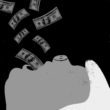Editor’s note: President Bush never misses an opportunity to tout the economic growth and job gains of the last few years. The Dow may be at record highs, but there’s an ugly truth behind the myth of today’s economic “good times.” We asked occasional contributor Perry L. Weed to tease out the real story from the current economic data. Weed is a retired Washington economist and lawyer whose thirty years in the nation’s capital included Senate and House staff assignments and a position at the U.S. Department of Commerce.
The familiar rhetoric of “two Americas” is all too real if you examine changes in the U.S. economy over the past thirty years. Although the economy is 150 percent larger than it was three decades ago, an overwhelming share of increases in income and wealth has flowed to a relatively small fraction of Americans. The U.S. has become the most unequal of rich nations. The high tide of prosperity for the middle class began receding in the mid-1970s, and their economic security is now in full retreat.
Being middle class once meant working hard, getting ahead, achieving financial and retirement security and expecting one’s children to do as well or even better. Now, after three decades of flat or falling real wages for most Americans, more than half of middle-income Americans think things will be worse for their children and future generations.
Average hourly wages and salaries of production and non-supervisory workers have fallen 5 percent since 1973. The Census Bureau’s recent annual report showed that, adjusted for inflation, the earnings of U.S. men were lower in 2005 than in 1973. The same report, however, had very good news for the top one-fifth of American households. They received more than half the nation’s income last year, with most of that concentrated in the top 5 percent.
GOOD JOBS GONE—The new “service sector” jobs, which for years have been replacing manufacturing jobs, pay less and offer fewer benefits. Already almost two-thirds of Americans report that they live from paycheck to paycheck. One-half say that no matter how hard they work, they cannot get ahead. Pension protection, employee health insurance and job security are eroding.
This shift toward service jobs has doubled in the last twenty-five years. Of the thirty occupations projected by the U.S. Department of Labor to see the greatest growth between now and 2014, most are in the service sector requiring only short-term on-the-job training and are categorized as either low or very low paying. Only a few are in high-tech areas and only six require as much as a bachelor’s degree. These new service jobs are mostly in retail sales and customer service, and include janitors and cleaners, waiters, restaurant workers, home health aides and nursing assistants.
On the other end of the spectrum, CEOs saw a pay increase of almost 300 percent between 1990 and 2005. American executives now skim off over 10 percent of corporate gains for themselves. Recently the ratio of the pay of the chief executive of America’s top corporations to that of a production worker reached an unprecedented 431 to 1, on average, an annual rate of $11.8 million to $27,460.
All the hoopla over the supposed democratization of the stock market is simply empty rhetoric. Yes, workers have been thrust into the market through 401k plans that replaced pensions; but in actuality, two-thirds of total stock market wealth is held by only 5 percent of American stockholders. And the median holding for those households that do own stock is only $24,300. So much for the “ownership society”!
THE END OF INCOME PARITY—After World War II, Americans produced the world’s first truly middle-class nation. In the thirty years following the war, the real income of all American families, including the poor and almost poor, doubled. The nation, by every economic measure, was becoming more equal. That has all changed.
For the past thirty years, the trend toward economic inequality has rolled back the post-war progress that had moved the nation toward a more equitable distribution of income and wealth. For the least wealthy 50 percent of families, according to a 2006 Federal Reserve report, the share of total U.S. family wealth has fallen to a meager 2.5 percent. The wealthiest 10 percent hold 63 percent of family assets.
This income and wealth gap is growing with an unrestrained force—and is wider than in any other advanced country. America has regressed in spirit to the Gilded Age, at the end of the nineteenth century, with its flagrant excesses. The last fifteen years alone have witnessed the most colossal amassing of huge fortunes in U.S. history. The nation now boasts more than 400 billionaires.
Since 1946, the effective federal tax paid by the richest Americans has fallen by 60 percent, and yet the top priority of Republicans in Washington remains tax cuts for the wealthy and for corporate and financial entities. The herculean efforts by Congressional Republicans to repeal the estate tax, for instance, which affects only the wealthiest 2 percent of families, underscores the linkage between political polarization and economic inequality. Those benefiting the most from our economy are simply not paying in fairly in proportion to what they are taking out.
WAR ON THE MIDDLE CLASS—Why are we sinking into greater inequality? The interests of business, finance and the wealthy predominate and have nearly eliminated such mediating and countervailing forces as organized labor and a responsive government, forces that have historically provided balance and social support. The bargaining power of workers has shriveled. Elected officials have been captured by moneyed interests. The rewards of globalization have mostly flowed to shareholders and their enablers. Bankruptcy laws, as they are now used by the airlines and auto-parts industries in particular, hasten worker losses and weaken unions. The social beliefs that favored equality and progressive taxation have broken down. For the past twenty-five years, U.S. government policies have consistently favored the wealthy at the expense of working families, notably in tax, healthcare and retirement policies. And yet, in our national dialogue, public discourse about inequality is abruptly shut down, whenever it arises, as un-American class warfare.
The Bush administration has pushed regulations that strip millions of workers of overtime pay, has encouraged union-busting, has advanced tort reform favoring corporations and has done the bidding of credit card companies in passing revisions to bankruptcy laws that further incapacitate distressed debtors. And, of course, there is the failure to raise the minimum wage, stuck at $5.15 per hour since 1997, with its purchasing power severely reduced by inflation since then. Since 1973, the real minimum wage has decreased by nearly one-fifth. At the current minimum wage, a wage earner with two children would have to work 150 hours a week to raise the household income above the poverty line.
Taken together, the rewards of our recent economic recovery, the productivity gains, advances in technology and recent business-friendly federal domestic policies have merged to widen the divide between the prosperous—the top 20 percent of households—and the struggling majority of American families. The economic good times touted by the Bush administration do not reflect what these families experience in their daily lives: that is, flat real wages, greatly increased costs for basic necessities, lower-paying jobs, and diminishing savings and wealth accumulation.
Meanwhile, corporations—and their highest-echelon personnel—are grabbing an increasing share of the economic pie. The top 5 percent of the wealthiest American families now receive 20 percent of total U.S. income, up from 15 percent in 1974. In 2001, 7 percent of national income went to corporate profits; in 2006, 13 percent. In the past five years, domestic corporate profits have soared by an extraordinary 72 percent.
The evidence mounts that the benefits of the U.S. economy and its global agenda are flowing inordinately to corporate investors, top managers, and their professional enablers at a cost to ordinary Americans in low wages, outsourced jobs, broken promises, lower living standards, deteriorating towns and cities, and unsustainable levels of foreign debt. Even though business productivity has risen 16.6 percent, earnings for 80 percent of working American families are nevertheless actually lower than they were five years ago. The household-income gains over the past thirty years can mostly be traced to employees’ longer work hours and the money from married women entering the paid workforce. In 1970, 41 percent of wives participated in the labor force; now, in order to make ends meet, over 60 percent work. And all this is happening as the business cycle peaks and “times are good.”
Most Americans daily experience a financial squeeze and the frenzied demands of their jobs and private lives. They see globalization fracturing the traditional linkages of skills, education and wages. They see the longstanding social contract with business and government unraveling in the form of stagnant wages, unaffordable health care, soaring energy costs, the cost of education spiraling out of reach and with it the promise of upward mobility, and the gradual demise of pension, retirement and health plans—the mainstays for aging Americans. In short, their standard of living is declining or threatened.
Yet political and media elites wonder aloud in bewilderment why Americans are wrestling with economic insecurity. Most Americans get it, however. They realize their country is on the wrong track and that its government institutions and elected leaders are failing them.
COSTS AND NEEDS DON’T BALANCE OUT—Each year more Americans fall below the federal poverty line. The number of poor Americans, as defined by the federal government, rose to 37 million in 2004. That was 12.7 percent of the population. In the same year, another 54 million Americans earned less than $39,000—an amount double the poverty line, which is referred to as “near poor.” The poverty rate did not change between 2004 and 2005.
Discussions about the middle-class squeeze do not usually include the poor and near poor. Yet these most disadvantaged among us are falling the furthest behind. Politicians avoid discussing the unpleasantness of poverty and its sources. And so, this large group of persons remains invisible.
The average real income of the bottom 90 percent of American taxpayers declined by 7 percent between 1973 and 2000. The number without health insurance has increased by millions in recent years and has now risen to 15.9 percent. There are now 46.6 million uninsured Americans—an all-time high. Affordable housing is diminishing. More and more wage earners are in danger of slipping into poverty. Rural communities across the nation are dying as the rural-urban pay gap widens and farms are consolidated.
The inequality of income and wealth is driven heavily by social factors: that is, economic class, education, and family background. But the American ethos of upward mobility has to an extent counteracted these factors in the direction of helping the disadvantaged to achieve. Nevertheless, achieving the American dream is less likely now than it was thirty years ago. Studies show that only a small share of poor children ever end up earning a high income.
Rapidly rising college costs are squeezing out students from low-income families. The average cost per year at a public college, for an in-state student, is $12,127, a 25 percent increase since 2001. A private university costs, on average, $29,026. The American dream—start out poor, go to college, work hard and have a good life—is, for most Americans, a fading possibility. An expanding, vital middle class is both the engine for a sound economy and the avenue by which citizens participate in their country’s progress and promise. Without it, not only our economy but our very democracy is at risk.
A DEBTOR NATION—Awash in astonishing levels of private debt, Americans continue to borrow just to maintain their standard of living. American families have amassed record housing, auto, education and credit card debt. In the last decade, the average family’s credit card debt increased by 81 percent, its student loan debt rose by 137 percent and its mortgage debt jumped 154 percent. Debt payments now consume 19.4 percent of the income of the average American family.
Instead of using home ownership to save, we use the equity in our homes like ATMs and credit cards. The personal savings rate in 2005 dropped to minus 0.4 percent, the first time since 1933 that the average American’s spending has exceeded his disposable income. With the economy more leveraged by household debt than ever before, more Americans are at the mercy of credit and mortgage interest rates. As the debt piles up, we are wantonly incurring intergenerational obligations—for which our children and grandchildren will have to pay.
The downward pressures on the earnings of Americans accelerate: a preponderance of new jobs at fast-food restaurants, low-price-merchandise chains and big-box retailers; global trade and new waves of downsizing, outsourcing and offshoring; the replacement of workers with technology; and the massive flow of immigrants looking for jobs. More than half the total recent workforce growth has occurred among foreign-born workers. Out of necessity, a growing percentage of college graduates settle for low-paying jobs that do not require a college degree. The downward economic slide for those without a college degree is more severe. The new jobs that have been created since 2003—heralded as a grand accomplishment by the present administration—have barely kept up with the population growth.
Recent evidence confirms the trend that our children’s standard of living will not surpass ours. In 2006 the ascent to self-sufficient adulthood is steeper than at any other time since World War II. Paying for school, securing a good job, affording a house and supporting a family are increasingly more difficult milestones for young adults to achieve. As the young move back home in growing numbers, three-generation households are far more numerous today than they were thirty years ago. It takes much longer for young Americans to climb to the next level of life.
There is more bad news. Because of rising inflation and flat or falling wages and salaries, Americans cannot pay for their basic cost of living without borrowing or drawing on the equity in their homes. The costs of housing, health care, education, energy, property taxes, and child and elder care have grown at two or three times the inflation rate. The share of family income spent for housing alone has risen to 33 percent. Basic necessities—mortgages, child care, health insurance, vehicles and taxes—now take up to 75 percent of the budget of today’s average two-income family, compared with 50 percent in the early 1970s.
DARWIN’S NIGHTMARE—We seem to have degenerated into a form of social Darwinism that would suggest clashing forces in the future. The prevailing national economic strategy has been to make business more profitable and less accountable and to reward the owners, investors and other wealthier Americans, not the great majority of workers and U.S. households. Workers have few oppositional protections. Organized labor’s economic clout to win higher wages and benefits is withering away. Business, contributing $1.4 billion in the 2004 election, outspent labor unions tenfold.
The soaring compensation of senior corporate executives, the increasing number of American millionaires and billionaires, the material excesses of our public and private elites, taken together, have very few precedents in American history. It is reminiscent of the last stages of other great empires. Most of the country’s elites and its leaders, unwilling to broach the subject of inequality and its ultimate dire consequences, appear to be asleep to—or purposely ignoring—these realities.
The absence of effective opposing forces to address the ominous rise in social and economic inequality is increasingly cause for alarm. Where is the national debate? How do we hammer out new policies to alleviate the growing imbalances in our republic, and with them stem the social unrest that threatens the public landscape? The challenge for Washington is to spread more equitably the benefits of economic growth—now enjoyed inordinately by those at the top—without undermining the economy that supports it.





0 Comments